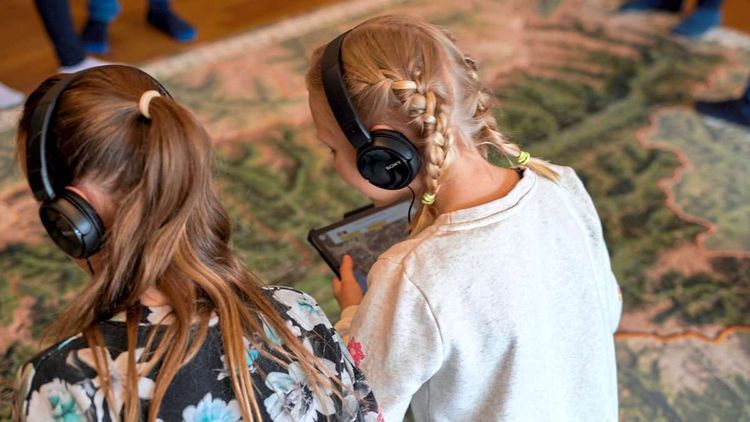In the dynamic and ever-changing field of digital marketing, the hunt for deeper, more meaningful customer involvement is never-ending. Brands are constantly seeking innovative methodologies to transcend the conventional, moving beyond passive consumption to forge authentic connections with their audiences. This imperative has catalyzed the ascent of Augmented Reality (AR) and Virtual Reality (VR) – not merely as technological novelties, but as pivotal instruments reshaping the very fabric of digital storytelling.
These immersive technologies are fundamentally transforming how narratives are constructed and experienced, shifting the paradigm from ‚telling‘ or ’showing‘ to profoundly ‚experiencing.‘ This article delves into the transformative power of AR and VR, exploring their unique capabilities in crafting compelling, immersive narratives that captivate, educate, and convert in the contemporary digital marketing arena.
Table of Contents
1. The Evolution of Storytelling in Marketing
2. Understanding Augmented Reality (AR) in Marketing
3. Understanding Virtual Reality (VR) in Marketing
4. The Synergy: Immersive Storytelling through AR/VR
5. Challenges and Considerations
6. The Future Outlook: What’s Next for Immersive Marketing
7. Conclusion
1. The Evolution of Storytelling in Marketing
Marketing, at its core, has always been about telling stories. From early print advertisements to radio jingles and television commercials, the narrative was largely one-way and broadcast-centric. The digital revolution, commencing in the late 1990s and accelerating with social media, introduced unprecedented levels of targeting and personalization.
However, even with sophisticated content marketing and video campaigns, a degree of detachment persisted. Customers continued to be largely passive recipients of brand communications. The discerning modern consumer demands more than just information; they seek interaction, personalization, and seamless experiences.
Traditional methods, while still foundational, are proving insufficient in a landscape saturated with content. The shift is palpable: from merely communicating a brand’s message to inviting the audience into the brand’s world. This fundamental change paves the way for immersive technologies to bridge the gap, redefining what it means for a brand to tell a story.
2. Understanding Augmented Reality (AR) in Marketing
The smooth blending of digital and real-world content is demonstrated by augmented reality, or AR. Unlike its fully immersive counterpart, VR, AR overlays virtual information, images, or objects onto a user’s real-world view. This typically occurs via smartphone cameras, tablets, or specialized AR glasses.

This technology enhances the user’s perception of their immediate environment, enriching it with digital layers without severing their connection to reality. Its accessibility, primarily through widely adopted mobile devices, has made AR a compelling and practical tool for marketers seeking immediate, interactive engagement.
Key Applications and Illustrative Examples:
- Product Visualization: Perhaps the most ubiquitous application, AR allows consumers to virtually „try before they buy.“ IKEA Place, a pioneering AR app, enables users to place true-to-scale 3D models of furniture in their homes, allowing them to visualize items and complement existing décor. Similarly, beauty brands like Sephora and L’Oréal offer virtual try-on features for makeup and hair colors. This empowers customers to experiment with products before purchase, reducing buyer hesitation and return rates.
- Interactive Advertising & Social Filters: AR filters have become a cornerstone of social media marketing on platforms like Snapchat and Instagram. Brands leverage these filters for engaging campaigns, allowing users to interact with branded elements or virtually wear branded accessories (e.g., Christian Dior’s AR sneaker try-on on Snapchat). These campaigns foster user-generated content and organic virality.
- Experiential Marketing: AR makes events more engaging by adding digital features to real-world experiences. The „Pepsi MAX: Unbelievable Bus Shelter“ campaign, for instance, used AR to create illusions in a bus stop, turning a mundane wait into a memorable, shareable experience. Movie promotions, such as Sony Pictures Entertainment’s web-AR campaign for Jumanji: The Next Level, allowed users to explore the film’s world through their real-life environment.
- Retail Enhancement: Beyond virtual try-ons, AR assists with in-store navigation, product information overlays, and interactive displays. These provide deeper insights into product features and origins. Brands like Nike have integrated AR into their retail apps to enhance the in-store shopping journey, guiding customers and providing personalized recommendations.
- The benefits of AR are multifaceted: it lowers the barrier to entry for immersive experiences due to smartphone ubiquity, significantly enhances product understanding, and drives higher conversion rates (up to 40% in some categories according to Deloitte). It also fosters a stronger emotional connection by enabling direct, personalized interaction with products and brand narratives.
3.Exploring Virtual Reality (VR) in the Marketing Domain
In contrast to AR, VR replaces the user’s physical surroundings with a completely immersive virtual one. Accessed primarily through VR headsets, this technology transports users to entirely new digital worlds, offering an unparalleled sense of ‚presence‘ – the visceral feeling of „being there.“ This profound level of immersion makes VR an exceptionally powerful medium for deep experiential storytelling. It enables companies to create distinctive, memorable stories that emotionally connect with consumers.
Key Applications and Illustrative Examples:
- Virtual Showrooms & Tours: VR has revolutionized industries where physical presence is traditionally paramount. Real estate companies offer virtual property tours, allowing potential buyers to explore homes from anywhere. Automotive brands like Volvo have created virtual test drives for new models (e.g., the XC90 VR experience), enabling customers to „experience“ the vehicle’s features. The travel industry, exemplified by Thomas Cook’s „Try Before You Fly“ campaign, used VR to let users virtually experience vacation destinations.
- Brand Experiences & Immersive Narratives: VR excels at creating bespoke brand worlds and compelling narratives that transcend traditional advertising. The TOMS Virtual Giving Trip is a poignant example: a VR experience that transported users to Peru to witness firsthand the impact of their „One for One“ shoe purchase, encouraging a deep sense of empathy and a commitment to the brand’s purpose. Patron Tequila’s „The Art of Patrón“ offered a VR tour of their distillery in Jalisco, Mexico, giving viewers an intimate look at their craftsmanship.
- Training & Simulation: While primarily used for internal training, VR simulations can also serve as powerful marketing tools by showcasing the complexity or quality of a product/service. For instance, a B2B software company could offer a VR simulation of their platform’s capabilities. GSK’s „Excedrin Migraine Experience“ used VR to help non-sufferers understand the debilitating effects of a migraine.
- Virtual Events & Conferences: With advancements in VR platforms, brands can host virtual product launches, fashion shows (e.g., Topshop’s VR catwalk show), and conferences within immersive digital spaces. This provides dynamic networking opportunities and broadens the reach beyond geographic boundaries.
The core strength of VR lies in its ability to generate profound emotional responses and create highly memorable experiences. The complete immersion minimizes distractions, allowing the brand’s story to unfold without external interruptions, fostering a unique and deep bond with the user.
4. The Synergy: Immersive Storytelling through AR/VR
The true potential of AR and VR in digital marketing lies in their synergy, moving beyond mere novelty to create compelling, participatory narratives. These technologies don’t just deliver information; they create worlds and situations that users can step into, interact with, and feel a part of. This active engagement is the hallmark of immersive storytelling.

Elements of Immersive Storytelling Amplified by AR/VR:
- Presence and Immersion: AR and VR are unparalleled in generating a sense of „presence“—the feeling of physically being in a virtual or augmented environment. This sensation is critical for emotional connection, as users feel directly involved in the brand’s narrative.
- Interactivity and Agency: Unlike passive video ads, AR/VR experiences often empower users with agency. They can explore, manipulate virtual objects, make choices, or directly influence the unfolding story. This interactivity deepens engagement and makes the narrative personally relevant.
- Emotional Connection: Strong emotions, ranging from wonder and exhilaration to empathy and understanding, can be evoked by AR/VR’s profoundly sensory and participatory nature. When a brand’s story is felt, not just heard or seen, it leaves a far more lasting impression and fosters brand loyalty.
- Sensory Engagement: Beyond visuals, immersive storytelling leverages spatial audio, haptic feedback, and even motion tracking to create a multi-sensory experience. This rich sensory input enhances realism and deepens immersion, making the story more vivid and memorable.
Detailed Case Studies Illustrating Immersive Storytelling:
- Guinness VR Experience : This VR experience transported users to the Guinness brewery in Dublin, allowing them to explore the brewing process. It transformed a brand tour into an engaging, multi-sensory journey, deepening appreciation for the product’s craftsmanship and heritage. The narrative was about the legacy, the process, and the passion.
- The North Face VR Expeditions: The North Face recognized the spirit of adventure in their audience and developed virtual reality experiences that transported viewers to Moab, Utah, and Yosemite National Park. Users could experience rock climbing or hiking in breathtaking virtual landscapes. This allowed the brand to tell stories of adventure, directly aligning with their brand values and immersing consumers in experiences their gear enables.
- Toms Shoes VR Experience: This campaign was a masterclass in empathy-driven storytelling. By putting users in the shoes of children receiving TOMS shoes in Peru, the VR experience directly connected the act of purchase to its real-world impact. It transformed a simple transaction into a powerful narrative of social good, reinforcing the brand’s ethical stance.
- Audi’s VR Showroom Experience: Audi developed a VR experience that allowed customers to configure a car, explore its features, and even take a virtual test drive, complete with realistic engine sounds. This allowed Audi to tell a story of innovation, luxury, and performance in an incredibly detailed way, moving beyond static images or videos to a truly experiential product showcase. The narrative here was about future-forward design and cutting-edge engineering.
These examples underscore that AR/VR storytelling is not about technology for technology’s sake. It is about using these powerful tools to create narratives that are felt, explored, and remembered, ultimately building stronger, more resonant brand relationships.
5. Challenges and Considerations
Despite the immense potential, the widespread adoption and effective implementation of AR/VR in digital marketing face several significant challenges that require careful consideration.
- Cost and Accessibility: Developing high-quality, immersive AR/VR experiences can be significantly more expensive than traditional digital content creation. VR, in particular, often requires specialized hardware (headsets like Meta Quest, Apple Vision Pro), which are not yet universally owned. While AR is more accessible via smartphones, sophisticated AR experiences still demand considerable resources. Justifying the Return on Investment (ROI) becomes critical, requiring clear objectives.
- Technical Hurdles and Development Complexity: Creating compelling AR/VR content necessitates specialized skills in 3D modeling, game development engines (like Unity or Unreal Engine), and spatial audio design. Optimizing experiences for various devices and ensuring seamless performance adds further complexity. Technical glitches or poor user experience can quickly detract from the intended immersive effect.
- Content Creation and Narrative Design: The art of storytelling in AR/VR is distinct from traditional media. It demands a new approach to narrative design, focusing on user agency, spatial storytelling, and sensory engagement. Simply porting a 2D video into a 360-degree format often fails to leverage VR’s full potential. Brands need to invest in creative talent capable of thinking immersively .
- Measuring ROI: Quantifying the direct impact of immersive campaigns can be challenging. While metrics like engagement time, interaction rates, and brand recall can be tracked, directly attributing sales or long-term brand equity to an AR/VR experience requires sophisticated analytics. It also needs a clear understanding of the customer journey within these new mediums.
- Ethical Considerations: The deep immersion offered by AR/VR raises important ethical questions. Concerns include data privacy (especially with biometric data collected by headsets), potential for psychological manipulation, and the blurred lines between reality and simulation. Marketers must prioritize transparency, user consent, and responsible design to build and maintain consumer trust in these nascent spaces.
Navigating these challenges requires strategic planning, a willingness to innovate incrementally, and a commitment to user-centric design principles.
6. The Future Outlook: What’s Next for Immersive Marketing

The trajectory of AR and VR in digital marketing points towards increasing integration and sophistication. Several key trends are poised to accelerate their mainstream adoption:
- Evolution of Hardware: We are already witnessing significant advancements in AR glasses (e.g., Apple Vision Pro, Meta’s ongoing projects) becoming lighter, more powerful, and less obtrusive. Concurrently, VR headsets are becoming more affordable and standalone, removing the need for powerful PCs. These hardware improvements will expand the user base and facilitate more seamless access.
- Advancements in Content Creation Tools: The development of more intuitive no-code/low-code platforms and AI-assisted content generation tools will democratize AR/VR content creation. This will make it more accessible for brands without vast budgets or highly specialized in-house teams. This will foster greater experimentation and innovation.
- Integration with the Metaverse Concept: While the „Metaverse“ is still largely conceptual, its underlying principles – persistent, interconnected virtual worlds – naturally align with the capabilities of AR and VR. As these virtual spaces mature, brands will find new avenues for marketing, from virtual storefronts and digital product placements to hosting immersive events.
- The Blurring Lines Between Physical and Digital Realities: The future will see an even greater convergence of the physical and digital worlds, driven by extended reality (XR) technologies (an umbrella term for AR, VR, and Mixed Reality). This „phygital“ approach will allow for seamless transitions between online and offline brand interactions, creating truly integrated customer journeys.
- Personalization at Scale: Leveraging AI and data analytics, immersive experiences will become hyper-personalized. Content may alter dynamically according to user preferences, VR showrooms could provide product recommendations based on real-time behavior, and AR filters could adjust to user emotions. This will lead to unprecedented levels of relevance and engagement.
The path forward indicates that AR and VR are not merely fleeting trends but foundational technologies that will increasingly redefine how brands connect with consumers, tell their stories, and drive commercial success in the digital realm.
7. Conclusion
The digital marketing landscape stands at the precipice of a profound transformation, propelled by the immersive capabilities of Augmented Reality and Virtual Reality. These technologies offer an unparalleled opportunity to move beyond the limitations of traditional digital channels. They elevate brand storytelling from passive consumption to active, experiential engagement.
By enabling consumers to not just see, but truly be a part of the brand narrative, AR and VR forge deeper emotional connections. They also enhance product understanding and create indelible memories.
While challenges related to cost, technical complexity, and ethical considerations persist, the relentless pace of innovation in hardware and content creation tools signals a future where immersive marketing becomes an indispensable component of a comprehensive digital strategy. For marketers striving to cut through the noise, cultivate authentic relationships, and deliver truly memorable brand experiences, embracing AR and VR is no longer an option—it is an imperative to get an advantage in the rapidly changing digital era. The magic of digital marketing services, unlocked by AR and VR, promises a future where every brand interaction is an immersive journey, leaving a lasting impression on the customer and redefining the very essence of digital engagement.
Quelle:






